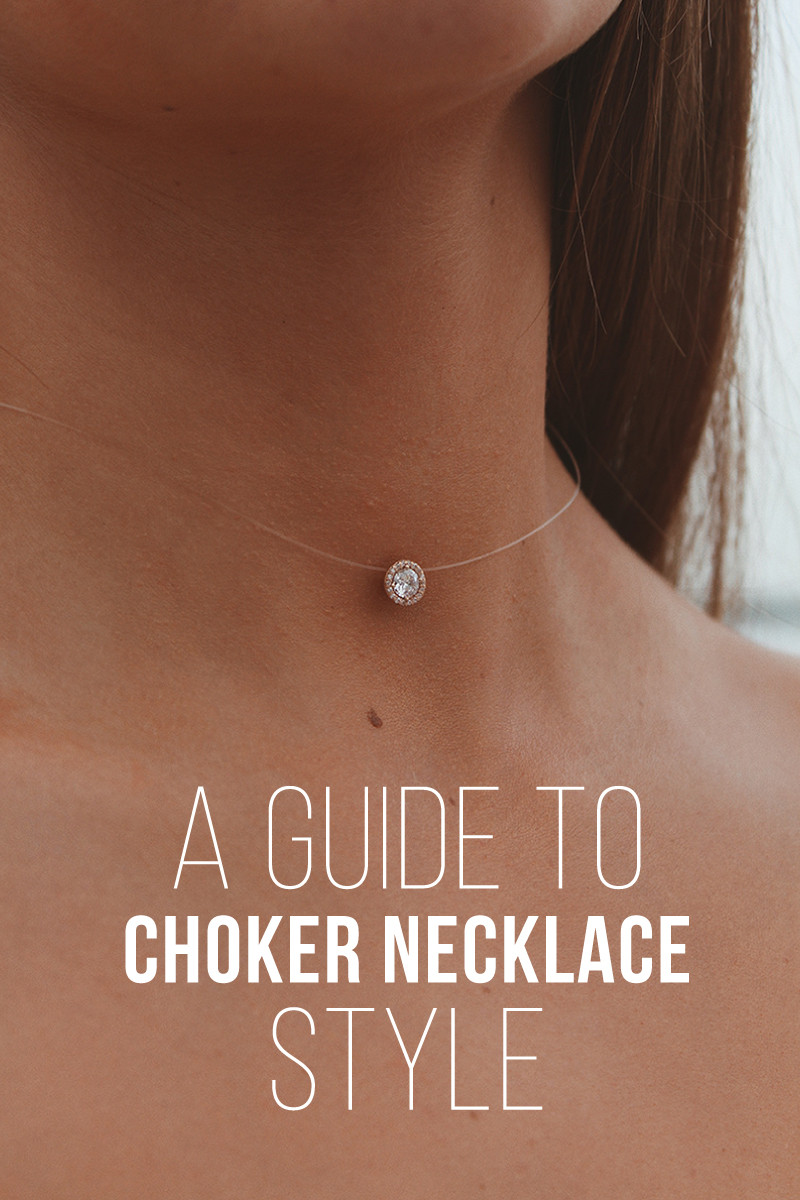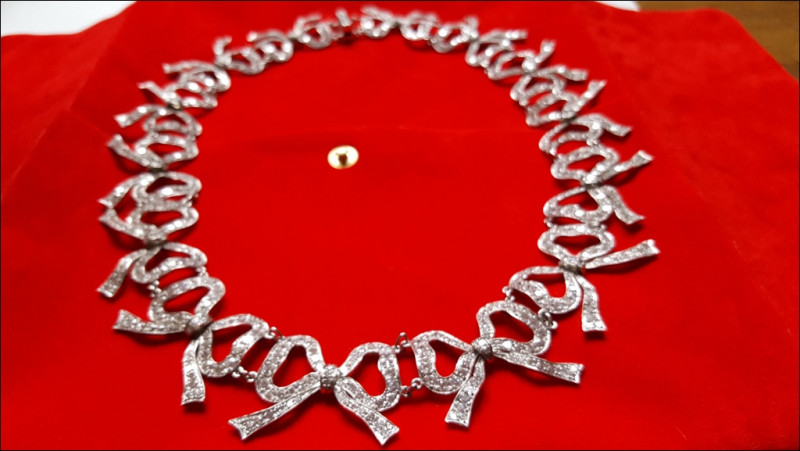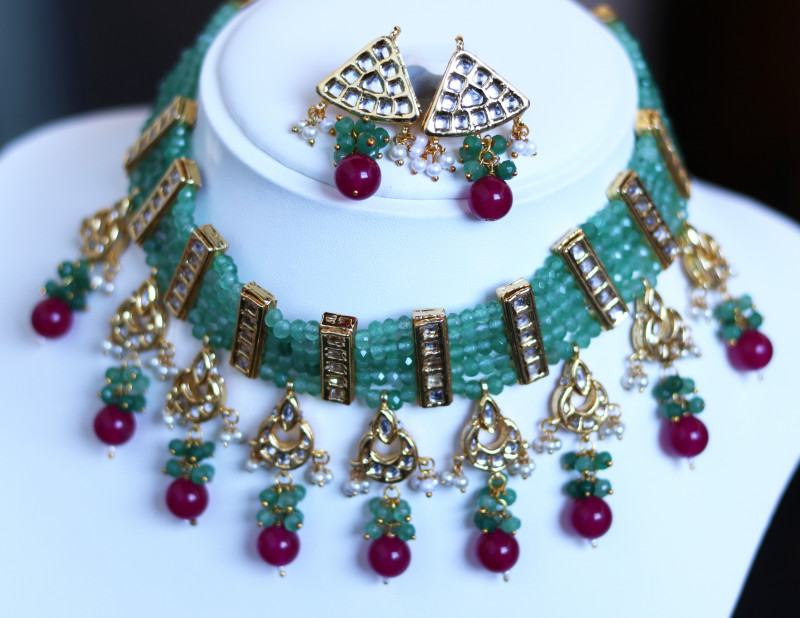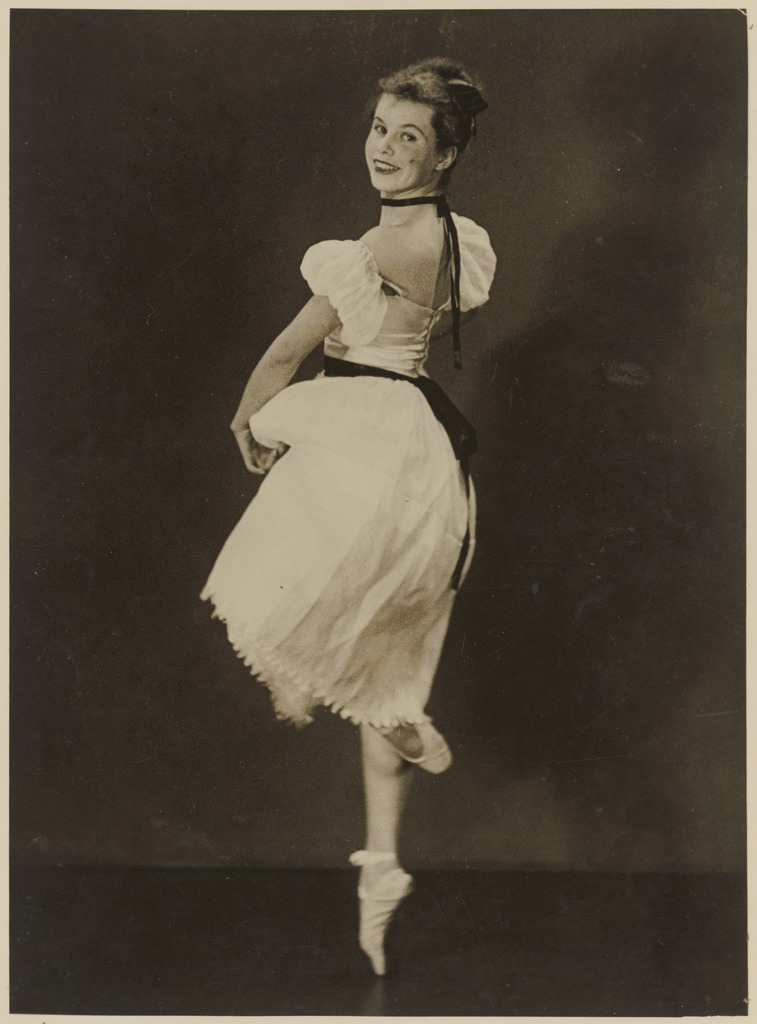
Choker Necklace Styles: Types, Meanings & History
 Choker necklaces are a versatile accessory with styles and materials for every personality. As 90s trends have reemerged in recent times, a myriad of choker necklace styles have come back to the forefront of fashion.
Choker necklaces are a versatile accessory with styles and materials for every personality. As 90s trends have reemerged in recent times, a myriad of choker necklace styles have come back to the forefront of fashion.
But are chokers in style? We’d argue they’re always in style. Though many solely associate them with 90s grunge, chokers have come in and out of the spotlight for hundreds of years.
Today, we’ll go over the types of chokers and what they mean, along with some history and inspiration for your next stylish choker moment.

What Is A Choker Necklace?
A choker is a short necklace, typically 14 to 16 in (~36 to 40 cm) long, that fits snugly around the neck or rests at the base of your throat. In terms of how a choker is supposed to fit, most recommend a minimum size of being able to fit a finger between the choker and your neck.
What is the difference between a collar and a choker? Though the term “collar” isn’t as widely used now, it refers to another short necklace that fits tightly around the neck, rather than at the base of the neck. Collar necklaces are usually shorter than chokers, but it’s more of a semantic difference than anything else.

What Does A Choker Necklace Represent?
Chokers have carried numerous meanings over time, from protection to status. Nowadays, chokers have generally come to symbolize nonconformity or rebellion.
Some experts have spoken on the duality behind choker symbolism. Vintage jeweler Susan Caplan told the Financial Times, “The choker is associated with everything from power and violence to femininity and wealth.”
Especially with modern ties to subversive styles of the 70s and 90s, choker necklaces simultaneously evoke feelings of gruff defiance and soft femininity — think the black chokers gracing the necks of young ballerinas in Degas paintings.
The choker necklace style’s symbolism has evolved and likely will keep evolving.
Types of Choker Necklaces
Chokers come in all colors and materials, each evoking different meanings or feelings. Below, we’ll highlight the many different choker styles, starting with the broad category of fabric choker necklace styles.

Fabric Choker
Unlike other accessories, chokers are commonly made from textiles, including velvet, lace, ribbon, suede, or leather. A simple black velvet is classic, which you can elevate by attaching a charm or pendant for a witchy or Victorian vibe.
Of course, you can wrap any fabric around your neck, finishing off with a bow in the front to tell everyone that yes, you are the present.
A boho or western option is a brown leather wrap-around (or thicker fabric), possibly highlighted with some turquoise for peak Americana style.
Intricate or sheer fabrics like lace bring an air of whimsy and flirtation, both covering and revealing simultaneously.

Gold Choker
Gold chokers are often single gold chains, and even the chains vary — rope, cable, Cuban link, the list goes on. Multiple chains add some dimension and draping. The colors can be warmer like rose gold and yellow gold or cooler like white gold.
A gold choker can be solid gold, gold-plated, or gold-filled. In terms of karatage, 14K gold choker necklaces are recommended for their durability and accessible price.
You can always add some flare with gemstones, pendants, or beads, too!

Silver Choker
Silver chokers are similar to gold in the varying chains and add-ons. Sterling silver is the most popular type, offering longevity and durability at an affordable price.
If you have a gemstone you’d like to show off, silver choker necklaces are a great neutral backing, allowing the gem to take center-stage. Silver chokers are also more subdued, perfect for a more laid-back or minimalist style.
Feeling in a particularly rebellious mood? Ditch the fashion “rules” by mixing some silver and gold jewelry together!
You can also opt for other metals like tantalum, titanium, tungsten, or platinum.

Pearl Choker
Pearl chokers can be as simple as a single pearl focal point or as elaborate as rows of beaded pearls layered a la Coco Chanel.
A single-strand pearl choker necklace evokes classic Mad Men-esque 50s or 60s style. Meanwhile, a necklace with one to three pearls beaded is a great modern, minimalist look.
If real pearl jewelry is beyond your budget, similar-looking glass or plastic beads are a budget-friendly alternative.

Diamond Choker
Like pearl chokers, diamond chokers are an elegant classic but kick it up a notch with extra sparkle. For a simpler approach, you can go for a — a super thin chain with a single “floating”diamond.
Many choose a classic choker with diamonds all the way around, which instantly elevates any look, or a thick band encrusted with diamonds. Plus, you can go for all white diamonds or mix and match some colored diamonds.
On the most elaborate end are the draped diamond choker necklaces, often evoking a Gothic-era style. A recent example that was the subject of controversy was the Maharaja of Patiala’s Cartier diamond choker worn by Emma Chamberlain at the 2022 Met Gala.
Another example — this time fictional — is the spectacular and now-iconic diamond choker necklace Nicole Kidman wore in Baz Luhrmann’s 2001 film Moulin Rouge. (Fun fact: Stefano Canturi designed that necklace with a whopping 1,308 diamonds — 134 carats worth!)

Tattoo Choker
Shifting away from opulent diamonds, we have the “tattoo” choker — a true 90s staple. This choker necklace was most often a stretchy black plastic (or fishing line!) lace-like design. It soon expanded into other colors, thicknesses, and add-ons like charms and beads.
The “tattoo” name comes from the choker’s resemblance to a popular barbed-wire bicep wrap-around tattoo, like that of actress Pamela Anderson.
Celebrities and media helped popularize tattoo chokers among teens and tweens; you’ll see the stars of Buffy the Vampire Slayer, Sabrina the Teenage Witch, and She’s All That all rocking tattoo chokers. Back then, these chokers were only a mere $0.50.
Tattoo choker necklaces remain a staple for many young adults. Their super affordable price, diversity in color — neon green, anyone? — makes them a cool-kid mainstay.

Indigenous Chokers
The choker necklace style has particular significance in many indigenous cultures.
One example is the Native American “bone” or “hairpipe” choker, which typically has stacks of horizontal beads intercepted with vertical beads, tied with leather in the back. These were worn for protection during battle to protect the jugular vein from attack.
A second example is the stiff, metallic coil or stack of rings, seen in a few Asian and African cultures, like those worn by women in Burmese Kayan culture.
Maasai collars and chokers are another African style, which feature elaborate, colorful beadwork.
That’s just scratching the surface of the many indigenous choker styles out there, many of which play into the choker necklace’s history.
History of Chokers
Archeological evidence shows people have worn necklaces for over 120,000 years. One of the earliest examples is the choker dating to 2600-2450 BC found buried with Queen Puabi of Ur.
As is often the case, fashion wasn’t just decorative in ancient times — it was often protective.
Accessories like chokers covered especially vulnerable body parts, like the bone chokers worn by Native Americans mentioned earlier. Protective chokers were also seen on Middle-Ages noblewomen for protection from the bubonic plague.
Religious significance also played a role, like the gold chokers of ancient Egypt meant to emulate the golden skin of Egyptian sun god, Ra. Northern Europeans similarly wore neck rings around 3000-1000 BC to emulate those of Celtic gods.
 Pictured above: Anne Boleyn, Queen of England, Probably an Early French Hood Portrait | Image credit: Ann Longmore-Etheridge, Flickr
Pictured above: Anne Boleyn, Queen of England, Probably an Early French Hood Portrait | Image credit: Ann Longmore-Etheridge, Flickr
Chokers in the 1500s to 1800s
The idea of wearing chokers for protection, especially in battle, began their association with danger. This association became less literal — though retroactively ironic — when choker popularity in Europe gave us arguably the most famous royal choker: that of Anne Boleyn seen in her 1500s-era portrait, shortly before her beheading in 1536.
Anne Boleyn’s choker featured a long string of pearls, complete with a “B” monogram pendant — long before personalized name necklaces became popular in the 1980s.
Over in India, portraits from 1526 to 1761 depict men and women covered in gems, starting at the neck with chokers and layering those jewels down — including that of Mumtaz Mahal, whose husband built the Taj Mahal as her tomb.
The style spread in Europe during the Enlightenment (1685 to 1815), helped by nobles like Marie Antoinette with her ribbon bow and diamond chokers.
In the fatal aftermath of the French Revolution (the “Reign of Terror” period), French women wore red ribbon chokers in remembrance of the 27,000 who lost their lives.
British teens in the 1700s started wearing chokers to mock the French, while French prostitutes adapted the style to a black ribbon choker to identify their occupation. Ballerinas, who were stigmatized similarly to prostitutes at the time, also adopted the black ribbon choker.
In the 1800s, broad chokers gained popularity after Alexandra of Denmark, Princess of Wales at the time, started wearing them, allegedly to hide a neck scar. Her mother-in-law Queen Victoria adopted the necklace, too.
 Pictured above: Moya Beaver dancing in costume with choker worn in productions of the Lightfoot-Burlakov First Australian Ballet, ca. 1935 | Image credit: National Library of Australia from Canberra, Australia; Public Domain
Pictured above: Moya Beaver dancing in costume with choker worn in productions of the Lightfoot-Burlakov First Australian Ballet, ca. 1935 | Image credit: National Library of Australia from Canberra, Australia; Public Domain
Modern Chokers: 1900s to Today
Chokers throughout the 1900s arose during pivotal moments of societal change.
The 1920s saw British dowagers wearing more formal chokers while others wore “dog collar” (a.k.a. “bib”) chokers or long pearl necklaces wrapped around to be part-choker. The word “choker” as a necklace style also came about in the 1920s.
During the Great Depression (1930s) in America, simple black chokers were sometimes worn as symbols of secret lesbianism.
The “dowager fashion” was revived by young American women in the 1940s, as reported by Life magazine in 1944.
During the 1970s, men brought chokers back. The chunky, spiked chokers of the punk movement also helped, and the trend reflected the broader societal changes in gender expression. Male celebrities like David Bowie, John Lennon, and Mick Jagger helped spur the trend.
Similarly, male celebrities like Lenny Kravitz and Prince joined female celebrities in popularizing choker necklaces again in the 1990s.

Which Choker Necklace Style Is Your Favorite?
By now, you have the knowledge to decide what kind of choker you should wear. Whether you take inspiration from celebrities with a high-fashion diamond choker, flex your DIY muscle with a homemade one, or go for a simple ribbon, the options for chokers are seemingly endless.
The best choker necklaces are the ones that make you feel like your best stylish self!
Ready to shop? Browse our collection of chokers today!
Search the Fashion Encyclopedia
Related Auctions
Related Articles
Jewelry gemstones are always tops in online demand
3rd Jan 2021
Sapphire Rings, Pendants & Earring Jewelry.Sapphire is a range of corundum, which is an aluminum oxide, and transpires in various colors such as pink, yellow, blue, and green. Any corundum jewel that is not red tone is known as sapphire.
10th Apr 2019
Amethyst Facts, Myths & Legends, Leonardo Da Vinci once wrote that Amethyst was able to dissipate evil thoughts and quicken the intelligence. * Amethyst was worn by Egyptian soldiers in battle for bravery and courage.
13th Jun 2019
Latest Articles
Titanium is a popular jewelry metal known for being lightweight, durable, and affordable. Learn all about titanium, how it compares to similar metals, and the pros and cons of titanium jewelry.
7th Feb 2023
Learn all about tungsten jewelry - from its history and uses to its durability and care. By the end of our guide, you’ll know if tungsten is right for you!
7th Feb 2023
Thinking about adding some timeless white gold jewelry to your fine accessories collection? Here’s all there is to know about sophisticated white gold!
29th Jan 2023




